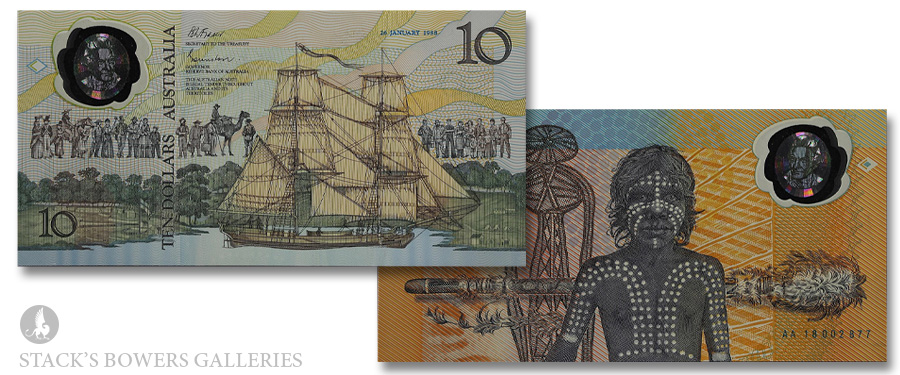
Australia made notaphilic history when it issued the world’s first polymer banknotes on January 26, 1988. These commemorative $10 notes marked the bicentennial of the establishment of a British colony at Sydney Bay, called New South Wales, an event that is pointed to by many as the birth of Australia.
Years of research into the feasibility of using polymer for banknotes culminated in the early 1980s with a polymer substrate viable for banknote use. After a battery of tests, the leadership of the Reserve Bank of Australia – the country’s central bank – authorized a limited production of commemorative notes. The 1988 commemorative banknotes offered advanced security features, including an optically variable device and, according to a folder included with some of the notes when they were released, intaglio and offset printing, and a watermark.
The Reserve Bank of Australia’s website describes the note’s face design: “The banknote incorporates an optically variable device that portrays Captain James Cook. It features a vessel of the First Fleet, HMS Supply, the first ship to drop anchor in Sydney Cove, and a frieze of figures across the landscape, beginning with convicts and continuing with subsequent waves of migration to Australia.”
And the back: “The culture of Aboriginal people is represented through layered imagery and patterns on the other side of the banknote. In its centre is an image of a youth with body decoration that was commissioned from the artist, Wayne Williams. Ancient rock paintings from Deaf Adder Gorge, Western Arnhem Land, appear behind the figure and a ceremonial Morning Star Pole, created by Terry Yumbulul (Djangu), is placed between the youth and the ancestral paintings. Different styles of art works are depicted in the background: hand stencilling; dot painting based on works acquired by the Bank from Paddy Carroll Tjungurrayi (Warlpiri; Anmatyerr); and cross-hatching or rarrk from a bark painting commissioned from George Milpurrurru (Yolgnu).”
Within a decade, Australia had fully transitioned to polymer banknotes and in subsequent years, other nations followed Australia’s lead, introducing their own polymer banknotes.
Australia’s groundbreaking 1988 polymer banknotes are generally inexpensive, affording collectors interested in the evolution of paper money – and its transition into substances other than paper – the opportunity to add an example to their collections.





